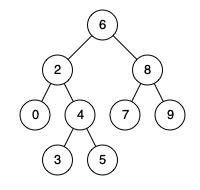Difficulty: Easy
Related Topics: Tree
Given a binary search tree (BST), find the lowest common ancestor (LCA) of two given nodes in the BST.
According to the : “The lowest common ancestor is defined between two nodes p and q as the lowest node in T that has both p and q as descendants (where we allow a node to be a descendant of itself).”
Example 1:

Input: root = [6,2,8,0,4,7,9,null,null,3,5], p = 2, q = 8Output: 6Explanation: The LCA of nodes 2 and 8 is 6.
Example 2:

Input: root = [6,2,8,0,4,7,9,null,null,3,5], p = 2, q = 4
Output: 2
Explanation: The LCA of nodes 2 and 4 is 2, since a node can be a descendant of itself according to the LCA definition.
Example 3:
Input: root = [2,1], p = 2, q = 1
Output: 2
Constraints:
- The number of nodes in the tree is in the range
[2, 10]. -10 <= Node.val <= 10- All
Node.valare unique. p != qpandqwill exist in the BST.
Solution
Language: Java
class Solution {
// 最大公共祖先定义:是两个节点所有公共祖先中离根节点最远的
// BST 的性质:左子树节点 < 根节点
// 右子树节点 > 根节点
public TreeNode lowestCommonAncestor(TreeNode root, TreeNode p, TreeNode q) {
// LAC 只能在左子树中
if (p.val < root.val && q.val < root.val) {
return lowestCommonAncestor(root.left, p, q);
}
// LAC 只能在右子树中
if (p.val > root.val && q.val > root.val) {
return lowestCommonAncestor(root.right, p, q);
}
// p 和 q 一个在左子树中,一个在右子树中
// 那么 root 就是 LCA
return root;
}
}

